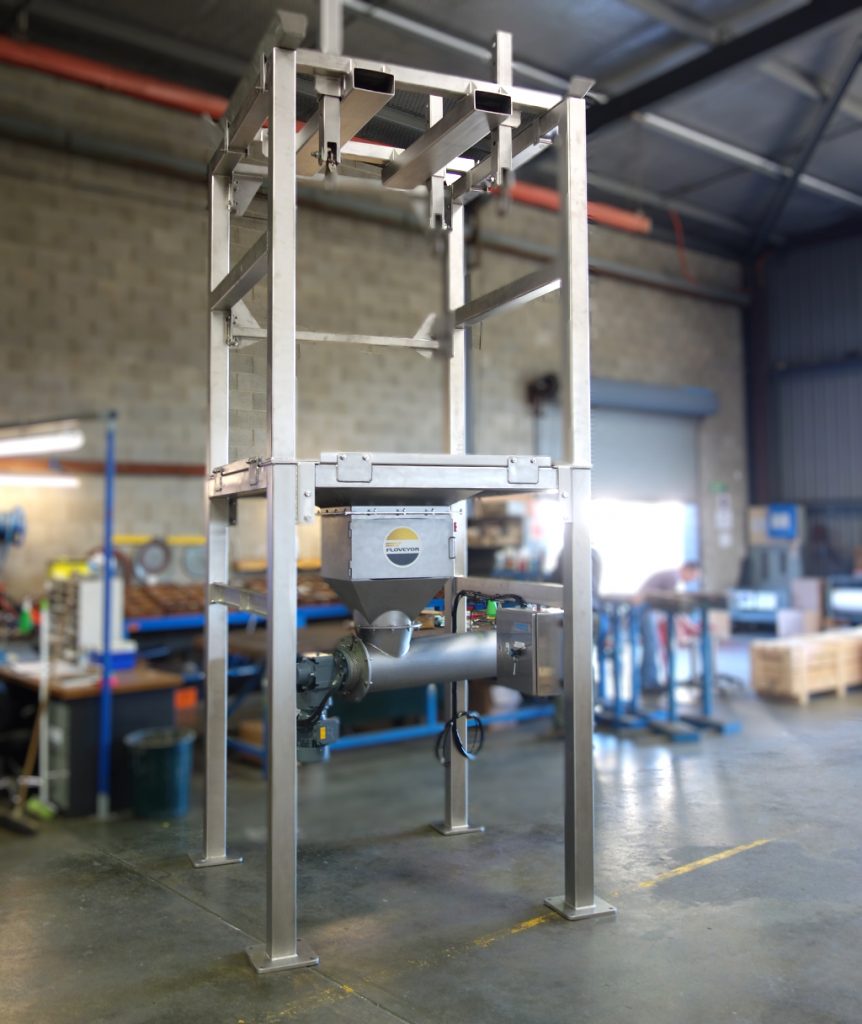It’s a problem we see all the time.
As a business grows, they outgrow the way they’re managing their bulk material handling. This is a particularly painful situation because it can require a new plant design and new equipment – and that all adds up to a large capital outlay.
Growing food processing business rethinks their operation
This was exactly the situation for a new customer in the food processing business in Australia. They needed a bulk bag system for the materials transfer of chickpeas into two cookers. Onsite workers were getting by with a sack tip directly above a single cooker, but they wanted to expand production, which meant they had to go to market.
Their requirements included:
- 500 kg bulk bags of chickpeas
- Very minimal or no retention of material
- High-speed conveying of 6000 kg/h
Deciding to change the current process
The customer had narrowed their decision to two choices:
- Keep their existing operation but use a hoist
- Invest in a Floveyor conveyor
They approached us with a thoughtful list of questions and concerns:
- What is the cleaning process?
- How reliable is the machinery?
- What are the reasonable throughputs we can expect?
- What is the life span of the Floveyor ropes?
- How do we manage material retention in the Floveyor tube?
- What if granules get jammed in the Floveyor?
- What is the dust impact?
- What are the noise levels?


Testing conveyor throughput of chickpeas
The first step was to prove the Floveyor can deliver the required throughput. We took delivery on a 25 kg bag of chickpeas and headed to our research centre. You can watch the results, which provided a 10,000 kg/h transfer rate of chickpeas (5.5 – 7 mm) with almost no residue. That’s 67 per cent above the required rate, or 167 per cent attainment of the goal.
Ideally, the customer would make a Floveyor decision on the back of those results. We’d love to report that when the Floveyor machinery exceeds their expectations on ease of cleaning, noise levels, reliability, rope life span, and health and safety issues, customers always raise a purchase order. But that’s not the reality of how business works.
Delivering the best conveying solution for our customers
What happened next isn’t unusual – our chief engineer worked directly with the customer’s project manager and their engineering firm on the plant layout. Every plant operation is different, and we’re committed to making sure customers get the most out of their conveying solution. The good news is we could fit our equipment in their plant and provide direct support, and we didn’t incur any of the work safety risks associated with their second option – the hoist arrangement.
In March, the customer went to market to assess suitable vendors and solutions and wanted delivery and installation by July. We were able to meet all their requirements and had our equipment onsite before the deadline.

Floveyor machinery for chickpea materials handling
This is where it gets technical.
Due to the site layout and existing equipment providing restrictions in the path of the conveyor, we supplied an F3 76.1 mm/3” Floveyor Aero-Mechanical Conveyor with a 2.2 kW drive. It’s running on a 5.7 m vertical then turning 90 degrees and running 6 m horizontally along the roof to the cookers inlet. The conveyor was equipped with a Stainless Steel 304L Bulk Bag [FIBC] Frame supporting 500 kg bags of chickpeas loaded from a forklift. The FIBC’s were reusable with bottom spout ties, which required a dust-tight untying chamber.
The bulk bag frame feeds into a 9” dosing Screw feeder which provide the customer with accurate control of the chickpea infeed, along with the ability to start and stop as required and manage partial bag loads. All the equipment supplied was suitable for FDA/EC food compliance undergoing regular nitric and caustic acid sanitation and wet washdown, including the drives which required corrosion resistance paint specification.
Is the customer happy?
Here’s where, ideally, we’d receive a glowing letter listing all the ways a Floveyor has changed their business. However, our customer is one of the 10 largest companies globally who control the food industry, and they do not like their name on case studies! It’s been two years and the last we heard they are achieving 10,000 kg/h throughput on chickpea conveying in their production setting and are concentrating on other production processes now. We’ll count that as a win!
If your food processing business is expanding and you’d like to explore how Floveyor machinery and equipment can help improve your operation, get in touch. We’re ready to help you find the best conveying solution for your plant.

